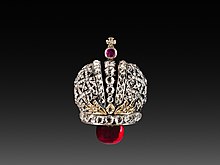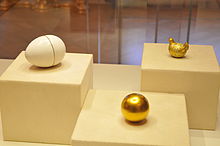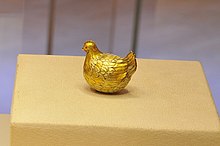First hen egg
The first hen egg is the first “imperial” Fabergé egg . It was made in the workshop of the Russian jeweler Peter Carl Fabergé and is attributed to the goldsmith and first workshop manager Erik Kollin . The egg was a gift from the Russian Emperor Alexander III. to his wife Maria Feodorovna for Easter in 1885.
The 6.4 centimeter high egg is made of gold coated with white decorative enamel. Inside there is a golden ball, which in turn contains a hen made of colored gold . The hen can be opened and previously hid a now lost gold crown set with diamonds and other gemstones , as well as a pendant with a large ruby .
The egg was probably made by Carl Fabergé based on the example of the golden egg with hen from the early 18th century, which is in the Royal Collection at Amalienborg Palace in Denmark . Two other such ornamental eggs are preserved in the Kunstkammer Vienna and in private ownership. The first hen egg came after the assassination of the Tsar's family and the flight of the Tsars mother's Danish exile in the Soviet state ownership and was sold in the 1920s to a dealer in Paris or Berlin. In 1934 the first hen egg was sold to Alfred Suenson-Taylor by Christie's London auction house . In 1976 it went to a New York jeweler, in 1978 to the collection of Malcolm Forbes , the publisher of Forbes Magazine , and in 2004 to Wiktor Felixowitsch Wekselberg . Since November 2013 it has been in the Fabergé Museum in Saint Petersburg .
background
In 1885 the Russian jeweler Peter Carl Fabergé began manufacturing elaborately designed Easter eggs, ten of which were sent to the court of the Russian Emperor Alexander III by 1894 . were sold. He gave them to his wife Maria Feodorovna on Easter . By 1916, 40 more eggs had been delivered to Emperor Nicholas II and given away to Alexandra Feodorovna and Nikolaus' mother, Maria Fyodorovna. The two eggs destined for 1917 were not delivered. In addition to these 52 “imperial” Fabergé eggs, more than a dozen decorative eggs were made for private customers. Most of the Fabergé eggs contained a surprise hidden inside, such as enamel miniatures by a court painter or a model of a ship or a carriage made from precious materials.
Various researchers ascribed the first hen egg not to Erik Kollin, but to his successor Michail Perchin . This different attribution is based on the assumption that Parchin did not come to the Fabergé workshop until 1885 or 1886, but as early as 1884.
In 2018 rumors started circulating that another egg from 1885 had been discovered in Russia. Since the first hen's egg was identified as the first Fabergé egg at an auction in 1934 by the head of Fabergé's London branch, and its provenance has been continuously updated since then, news of the new find has so far been rejected.
description
The 6.4 centimeter high egg is made of gold coated with opaque white decorative enamel. Two parts of the egg are separably connected to each other by a bayonet lock. Inside there is a matt golden hollow sphere, which in turn can be opened with a triple bayonet lock. The interior of the sphere has a surface structure that is intended to represent a nest. In it sits a 3.5 centimeter long hen made of white gold and yellow gold , with a red gold comb and small rubies for eyes. The hen can be opened on a hidden hinge on the rump and used to hide a now lost gold miniature of the tsar's crown set with diamonds and other gemstones , as well as a pendant with a large ruby .

A handwritten list drawn up by a court official around 1890 names a price of 4151 rubles and 75 kopecks for the first hen egg , 2700 rubles for two rubies alone. Neither the egg nor the surprises hidden in it have any marks or hallmarks. Nevertheless, the origin of the Fabergé house is beyond question. This also applies to the lapis lazuli egg , which so far could not be included in the series of "Imperial" Fabergé eggs and whose original recipient is unknown. It is a variation of the first hen egg. The bowl is made of lapis lazuli and does not contain a chicken, but a replica of the tsar's crown and a ruby that is attached to the crown and can be removed for use as a pendant.
Possible templates
The first hen egg was designed by Carl Fabergé, whose mother was Danish, probably based on the example of the golden egg with hen . The golden egg with hen was made in France around 1720 and was a gift from Charlotte of Orléans to the British Queen Caroline . The egg was bequeathed from Caroline to her youngest daughter Louise of Great Britain, Ireland and Hanover and thus came to the Danish royal court. Wilhelmine of Denmark bequeathed the egg to the Danish royal couple Christian IX in 1891 . and Louise von Hessen , the parents of Maria Feodorovna. The Golden Egg with Hen is part of the Royal Collection at Amalienborg Palace and is exhibited there in the Fabergé Chamber. The Danish decorative egg consists of an outer shell made of ivory , in which an egg with a golden shell is hidden. Inside there is a recess for holding a perfume bottle and a hinged white lid with a replica of a yolk. Under the flap is a hen made of sheet gold. Hidden in the opening hen is the golden model of a royal crown set with diamonds , the bow of which can be removed as a diamond-set gold ring.
Two other decorative eggs of this type are in the Kunstkammer Vienna and are privately owned, formerly in the Green Vault in Dresden. Both are characterized by a golden exterior and are not provided with a white outer shell like the Fabergé egg and its Danish model. Both eggs have a hinged lid with a simulated yolk and underneath a golden hen with a small crown and a diamond ring. The Dresden egg comes from the possession of August the Strong . It was in the family up to Friedrich August III. inherited from the last King of Saxony. In 1921 it was located in the Green Vault, but was restituted in 1924 and kept in Moritzburg Castle. When the Red Army marched in in 1945, it was rescued by the family. The Dresdner Schmuckei was auctioned off in November 1988 by the Geneva auction house of Géza Habsburg-Lothringen (a grandson of Friedrich August III.) And David Feldman to an unknown buyer. The Viennese jewelry egg comes from the possession of the Habsburg family .
Due to the numerous connections between Fabergé and the Russian tsar's court to the Danish crown and the years of Fabergé's youth in Dresden, it is unclear how the Danish or one of the other two models came about. Fabergé had been in contact with the court of the Tsars since 1882, when he received a gold medal at the All-Russian Industrial and Crafts Exhibition in Moscow. The Tsarina bought a pair of cufflinks at this exhibition . Grand Duke Vladimir Alexandrovich Romanov , a younger brother of Alexander III, was Fabergé's contact at the Tsar's court. The Tsar's wishes, such as the replacement of the diamond ring initially planned by Fabergé as a final surprise with a ruby pendant, were passed on to Fabergé by Vladimir. The correspondence between Alexander and Vladimir in this regard has been preserved, and after the hen egg was completed , Vladimir wrote a letter to the emperor explaining the function of the complex gift.
Provenance
The first hen egg was made by Emperor Alexander III. presented to his wife, Tsarina Maria Feodorovna , as a present for Easter in 1885. After the abdication of Emperor Nicholas II. In mid-September 1917, about 40 Faberge eggs for the government Kerensky for security in the Kremlin Armory brought, including the first hen egg . The tsarist family was murdered in 1918. The Fabergé eggs were likely handed over to the Council of People's Commissars of the RSFSR in February or March 1922 . In the 1920s it was sold in Paris or Berlin, probably by Antikwariat , the department of the Soviet Ministry of Commerce responsible for the exploitation of cultural assets , to a Derek or Frederick Berry from London. In 1934, Christie's London auction house sold the First Hen's Egg to Alfred Suenson-Taylor for £ 85 . In 1976, after the death of Suenson-Taylor, who had been promoted to 1st Baron Grantchester in 1953, the first hen egg was sold to A La Vieille Russie , a New York-based jeweler who specializes in Russian objects .
In January 1978, the First Hen Egg and Resurrection Egg were sold for $ 126,250 to Malcolm Forbes , publisher of Forbes Magazine . His heir Steve Forbes sold what was then the largest private Fabergé collection, with nine “imperial” eggs alone, in February 2004 for more than 100 million US dollars to the Russian Viktor Felixowitsch Wekselberg . With his The Link of Times Cultural and Historical Foundation , founded in 2000, Wekselberg pursues the goal of safeguarding Russian cultural assets that have been brought abroad and returning them to Russia. The first hen egg is in the exhibition of the Fabergé Museum in Saint Petersburg, which opened in November 2013 .
Exhibitions
There is no evidence of the presentation of the First Hen's Egg at one of the early exhibitions of Faberge's works, at the Paris World Exhibition in 1900 and the charity exhibition in March 1902 in the St. Petersburg Palais Derwis under the patronage of Alexandra Feodorovna. Only after the Forbes collection was sold was the first hen egg repeatedly shown at exhibitions. From October 2005 to February 2006, all Forbes eggs were shown in Brussels. The exhibition “Fabergé in Zurich - Treasures of the Russian Tsar's Time” showed the Fabergé eggs in June and July 2006 and then other works by Fabergé until September. From July to September 2009 the exhibition “Moscow. Splendors of the Romanovs ”in the Grimaldi Forum another presentation. From April to June 2011 took place in the Raphael Hall Vatican Pinacoteca , the "Faberge exhibition. Sacred Images ”instead.
Web links
- 1885 Hen Egg / First Hen Egg , private website with images and background information
- The Imperial Fabergé Eggs , website of the Fabergé jeweler
- Hen Easter Egg on the website of the Fabergé Museum, Saint Petersburg (English and Russian)
- Как устроены яйца Фаберже - взгляд изнутри , video of the Fabergé Museum, with the opening of several Fabergé eggs (Russian subtitles, first hen egg up to 1:20 min)
- Fabergé Research Site Newsletter Fall 2013 , private website for research on Fabergé eggs, images of the originals in Copenhagen, Dresden and Vienna
Individual evidence
- ↑ The Imperial Fabergé Eggs. Fabergé, accessed April 13, 2020 .
- ↑ a b c d The Hen Egg (the First Imperial Egg): A Fabergé Imperial Easter Egg presented by Emperor Alexander III to his Wife the Empress Maria Feodorovna at Easter 1885. (No longer available online.) Link of Time Foundation, archived from Original on June 1, 2012 ; accessed on April 14, 2020 (English).
- ↑ a b c d e Annemiek Wintraecken: 1885 Hen Egg / First Hen Egg. wintraecken.nl, January 2, 2019, accessed on April 13, 2020 .
- ↑ a b c d Fabergé Imperial Egg Chronology. In: Fabergé Research Site. 2020, accessed April 8, 2020 .
- ↑ Annemiek Wintraecken: Lapis Lazuli (Hen) Egg. wintraecken.nl, January 18, 2019, accessed on April 14, 2020 .
- ^ Henry Hawley: Fabergé and His Contemporaries. The India Early Minshall Collection of The Cleveland Museum of Art . The Cleveland Museum of Art, Cleveland 1967, 32nd Lapis Lazuli Egg. 66.436, pp. 72 .
- ↑ Golden Egg with Chicken. Retrieved April 13, 2020 .
- ↑ a b Hen Easter Egg. Fabergé Museum, accessed April 14, 2020 .
- ^ Fabergé Research Site Newsletter Fall 2013. In: Fabergé Research. 2013, accessed on April 14, 2020 .
- ↑ Annemiek Wintraecken: Fabergé Eggs on Exhibition 2005-2015. wintraecken.nl, January 22, 2019, accessed April 8, 2020 .

